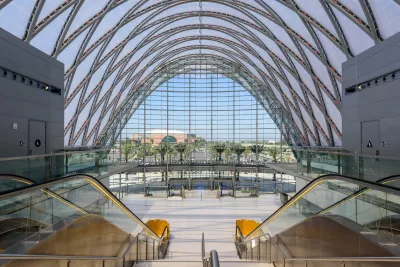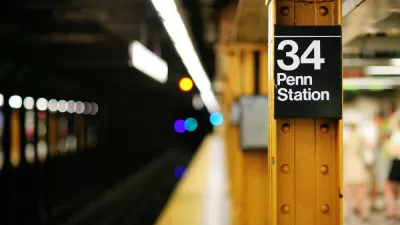Train-bus-bike connector stations have a long pedigree, and a reputation for anchoring neighborhood investment. But some criticize planned hubs for their perceived lavishness.

Following the tested example of New York's Penn Station, cities like North Charleston, Amarillo, and Anaheim are phasing in new "intermodal hubs" that combine rail, bus, and bike access to facilitate trips consisting entirely of non-auto modes. Supporters like Todd Litman, executive director of the Victoria Transport Policy Institute, argue that by improving the quality of transit trips on existing lines, cities can increase transit patronage.
Citing Anaheim's new ARTIC station, critics like UCI's Michael McNally call attention to costs ($188 million in ARTIC's case) and "the fact that ridership has not risen as dramatically as planners forecasted." Moreover, ARTIC includes luxury amenities like an oyster bar, which may be of questionable utility to transit patrons.
Litman disagrees, calling parking lots—especially those that are lit or covered, with courtesy signage—hubs for cars. "To encourage a true modal shift, he adds, 'we have to prioritize that level of convenience and comfort.'" Those who could afford to drive might then choose public options instead.
Note: Todd Litman is a longtime contributor and blogger for Planetizen. Check out his articles here.
FULL STORY: Are Intermodal Hubs Fancy Capital Projects or Anchors for Future Investment?

Alabama: Trump Terminates Settlements for Black Communities Harmed By Raw Sewage
Trump deemed the landmark civil rights agreement “illegal DEI and environmental justice policy.”

Planetizen Federal Action Tracker
A weekly monitor of how Trump’s orders and actions are impacting planners and planning in America.

How Atlanta Built 7,000 Housing Units in 3 Years
The city’s comprehensive, neighborhood-focused housing strategy focuses on identifying properties and land that can be repurposed for housing and encouraging development in underserved neighborhoods.

In Both Crashes and Crime, Public Transportation is Far Safer than Driving
Contrary to popular assumptions, public transportation has far lower crash and crime rates than automobile travel. For safer communities, improve and encourage transit travel.

Report: Zoning Reforms Should Complement Nashville’s Ambitious Transit Plan
Without reform, restrictive zoning codes will limit the impact of the city’s planned transit expansion and could exclude some of the residents who depend on transit the most.

Judge Orders Release of Frozen IRA, IIJA Funding
The decision is a victory for environmental groups who charged that freezing funds for critical infrastructure and disaster response programs caused “real and irreparable harm” to communities.
Urban Design for Planners 1: Software Tools
This six-course series explores essential urban design concepts using open source software and equips planners with the tools they need to participate fully in the urban design process.
Planning for Universal Design
Learn the tools for implementing Universal Design in planning regulations.
Jessamine County Fiscal Court
Caltrans
Institute for Housing and Urban Development Studies (IHS)
City of Grandview
Harvard GSD Executive Education
Toledo-Lucas County Plan Commissions
Salt Lake City
NYU Wagner Graduate School of Public Service





























